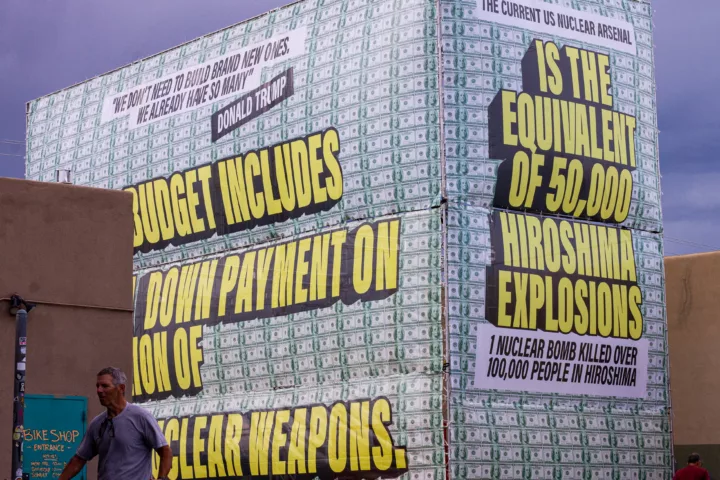Highlights of National Nuclear Security Administration Issues
In the House FY 2015 National Defense Authorization Act
Sources: House FY 2015 NDAA, pages 1516 – 1555 and budget tables beginning page 1643.
http://docs.house.gov/billsthisweek/20141201/CPRT-113-HPRT-RU00-S1847.pdf
Compiled by Jay Coghlan, Nuclear Watch New Mexico. Any comments by me are italicized.
The House FY 2015 National Defense Authorization Act authorizes $8.2 billion for the National Nuclear Security Administration’s (NNSA’s) nuclear weapons programs, in contrast to the Obama Administration’s request of $8.3 billion.
It meets the Administration’s $643 million request for the B61 Life Extension Program, and raises the $9.4 million request for the Long-Range Stand-Off (AKA air-launched cruise missile) nuclear warhead to $17 million.
It raises the $30 million request for dismantlements to $40 million.
It meets the $335 million request for the Uranium Capabilities Replacement Project (AKA the Uranium Processing Facility).
It raises the $196 million request for construction of the MOX Fuel Fabrication Facility to $341 million.
It cuts the $410.8 million request for the NNSA Office of the Administrator to $386.9 million.
SEC. 3111. DESIGN AND USE OF PROTOTYPES OF NUCLEAR WEAPONS FOR INTELLIGENCE PURPOSES requires the lab directors to “develop a multiyear plan to design and build prototypes of nuclear weapons to further intelligence estimates with respect to foreign nuclear weapons activities and capabilities.” This effort “emphasizes the competencies of the national security laboratories with respect to designing and building prototypes of nuclear weapons.”
This could possibly be abused by U.S. designers to design new nuclear weapons under the rubric of gathering foreign intelligence.
SEC. 3112. PLUTONIUM PIT PRODUCTION CAPACITY declares that the “production of plutonium pits and other nuclear weapons components must be driven by the requirement to hedge against technical and geopolitical risk and not solely by the needs of life extension programs.” It goes on to require the actual production of not less than 10 plutonium war reserve pits during 2024, 20 during 2025, 30 during 2026, and demonstration of the capability to produce 80 pits per year by 2027.
How convenient to delink plutonium pit production from the actual needs of Life Extension Programs, since the only LEP that required new pit production has been indefinitely delayed. This was for the so-called Interoperable Warhead, which faced exorbitant costs and lack of support by the Navy. Nevertheless, the House Armed Services Committee now mandates expensive and provocative expanded plutonium pit production for which there is no clear need. Ironically, the Los Alamos National Laboratory has been unable to conduct plutonium operations at its pit production facility since June 2013 because of nuclear criticality safety issues.
SEC. 3118. COST CONTAINMENT FOR URANIUM CAPABILITIES REPLACEMENT PROJECT limits Phase 1 of construction of the Uranium Processing Facility to $4.2 billion. That cap could be adjusted if the DOE Secretary submits a detailed justification, including “a detailed description of the actions taken to hold appropriate contractors, employees of contractors, and employees of the Federal Government accountable for the repeated failures within the project.” It also requires that uranium operations in Building 9212 cease by 2025.
Notably, the House NDAA does NOT contain a definitional change that NNSA shopped to key congressional committees that would have narrowed the Uranium Processing Facility’s mission, thereby helping to contain its costs (which was previously capped at $6.5 billion). Thus the Uranium Processing Facility could soon be headed for another budget crisis.
SEC. 3119. PRODUCTION OF NUCLEAR WARHEAD FOR LONG-RANGE STANDOFF WEAPON requires that “The Secretary of Energy shall deliver a first production unit for a nuclear warhead for the long-range standoff weapon by not later than September 30, 2025.”
This is meant to block the Administration’s proposed two year delay. Rushing into the LRSO nuclear warhead makes no sense because it puts the cart before the horse when work on the new air-launched cruise missile has yet to start.
SEC. 3120. DISPOSITION OF WEAPONS-USABLE PLUTONIUM requires another report on possible alternatives to the MOX Program for plutonium disposition, including their life cycle costs.
Nevertheless, as previously stated, the Act increases funding for construction of the MOX Fuel Fabrication Facility to $341 million.
SEC. 3132. ANALYSIS OF EXISTING FACILITIES AND SENSE OF CONGRESS WITH RESPECT TO PLUTONIUM STRATEGY requires “analysis of using or modifying existing facilities of the nuclear security enterprise… to support [NNSA’s plutonium] strategy, as part of critical decision 1 in the acquisition process for the design and construction of modular structures associated with operations of the PF–4 facility at Los Alamos National Laboratory, Los Alamos, New Mexico.” This is to include “plans to construct two modular structures that will achieve full operating capability not later than 2027,” all for the purpose of “meet[ing] the requirements for implementation of a responsive infrastructure, including meeting plutonium pit production requirements.”
But there are no actual pit production requirements. Recall that the Act delinks plutonium pit production from the actual needs of the nuclear weapons stockpile to become a hedge against undefined and indefinite “technical and geopolitical risk.” The Act also requires major expansion of production at LANL, when significant budget, environmental and safety issues for existing plutonium pit production remain unresolved (witness the use of unauthorized waste treatment processes by the Lab that led to the contamination of 21 workers and the closure of the Waste Isolation Pilot Plant, with initial estimates of $.5 billion dollars to reopen). The House Armed Services Committee’s mandate of expanded plutonium pit production is an ideological statement of nuclear weapons forever, rather than being driven by the technical needs of the stockpile. This is an unnecessary and provocative waste of taxpayer’s money that if enacted is doomed for failure.

